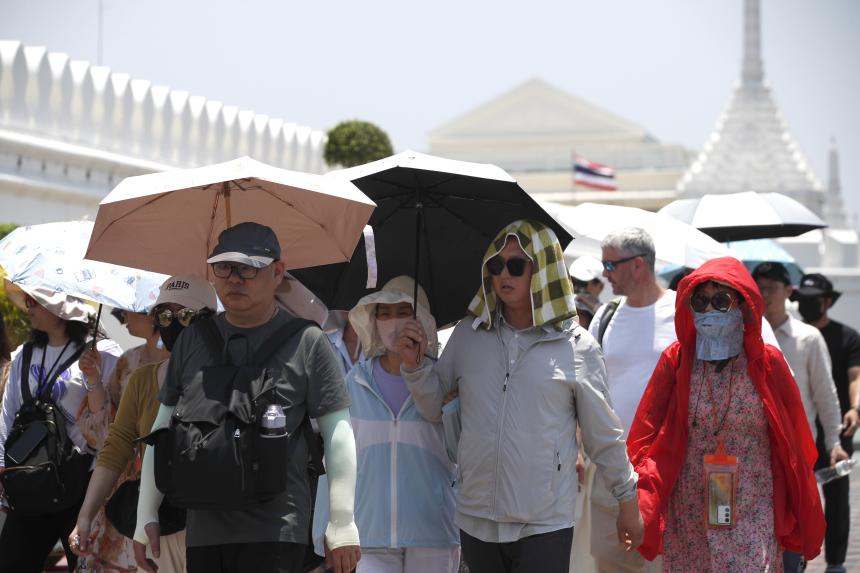BANGKOK – Large swathes of Asia are sweltering through a heatwave that has topped temperature records from Myanmar to the Philippines and forced millions of children to stay home from school.
In India, record temperatures have triggered a deadly heatwave and concerns about voter turnout in the nation’s marathon election. Extreme heat has also forced Bangladesh to close all schools across the country.
Extreme temperatures have also been recorded in Myanmar and Thailand, while huge areas of the Philippines are suffering from a drought.
Experts say climate change has made heatwaves more frequent, longer and more intense, while the El Nino weather phenomenon is also driving this year’s exceptionally warm weather.
Approximate voter turnout data after polls closed on April 26 in India – when stage two of the nation’s seven-stage general election took place – put voter turnout at 61 per cent. This was lower than the 65 per cent in the first phase, and 68 per cent in the second phase five years ago.
Among the states that headed to the polls last week was Kerala in the south, where media reports on April 29 said that at least two people – a 90-year-old woman and a 53-year-old man – were suspected to have died of heatstroke. Temperatures in Kerala soared to 41.9 deg C, nearly 5.5 deg C above normal temperatures. At least two people have also died in India’s eastern state of Odisha, where temperatures hit 44.9 deg C on April 28 – the highest recorded in April.
In neighbouring Bangladesh, students will continue to stay home this week, after schools across the country were ordered shut on April 29. A two-judge bench of the country’s High Court passed an order directing all primary and secondary schools and madrasahs (Islamic schools) nationwide to remain closed till May 5, affecting an estimated 32 million students.
Classes had just resumed the day before on April 28 – Bangladesh follows the Sunday to Thursday Islamic work week – after a week-long national school closure beginning on April 21 was lifted.
In the capital Dhaka, maximum temperatures are forecast to remain above 40 deg C until May 2. The average temperatures in the city over the past week have been 4 or 5 deg C higher than the 30-year average for the same period.
In Myanmar, the mercury hit 48.2 deg C in the town of Chauk in central Magway region on April 28, according to a statement from the country’s weather office. This was the highest temperature seen anywhere in Myanmar in April since records began 56 years ago.
Temperatures hit 40 deg C in the commercial hub of Yangon and 44 deg C in the second city of Mandalay on the same day, the weather office said.
In the Philippines, temperatures have sizzled around 40 deg C in parts of the archipelago in recent days, with the heat index – what the temperature feels like, taking into account humidity – in one area hitting 53 deg C.

More than half of the country’s provinces are facing a drought as El Nino exacerbates hot and dry conditions typical for March, April and May. This includes in Nueva Ecija province, where farmer Daniel Velasco pumps water from a well in a desperate attempt to save his wilting vegetables, as a scorching heatwave and the worst drought in years hit crops.
It has hardly rained on Mr Velasco’s plot of gourds and tomatoes since November. “I’m losing a lot of money,” the 57-year-old said, standing barefoot on the cracked ground in the northern province. He said his gourds died before he could sell them, pushing him deeper into debt.
Over in Thailand, more than three dozen districts across the nation’s 77 provinces have seen record temperatures in April, generally the hottest month of the year, with new highs beating records held as far back as 1958, according to data from the Thai Meteorological Department.
Thailand’s power usage surged to another record of 36,699MW on April 29 amid soaring temperatures, according to data on the state energy regulator’s website. That was the third time demand hit a new peak in about one week.
Bangkok’s heat index was listed as above 52 deg C and “very dangerous” on April 30, according to a Facebook post by the metropolitan administration.

Among those hit hardest in Bangkok are workers whose jobs require them to be outdoors all day, such as the motorbike drivers who deliver food and offer taxi rides through the city’s traffic-choked streets.
In Bangkok’s central Siam Square, Mr Suriyan Wongwan sweats while he waits to collect the food that he will deliver by motorbike as Thailand bakes through a heatwave.
“I’m afraid of getting heatstroke,” the 51-year-old said as the mercury hit 37 deg C, with humidity pushing the “real feel” to a sticky 43 deg C. “My self-protection is to drink more water, so I can carry myself through and not pass out,” Mr Suriyan said.
“In hot weather like this, I drink whenever I park my bike.”
The air-conditioned malls from where he collects his deliveries offer some respite, but he also worries the rapid change in temperature risks making him sick.
REUTERS, AFP, BLOOMBERG

